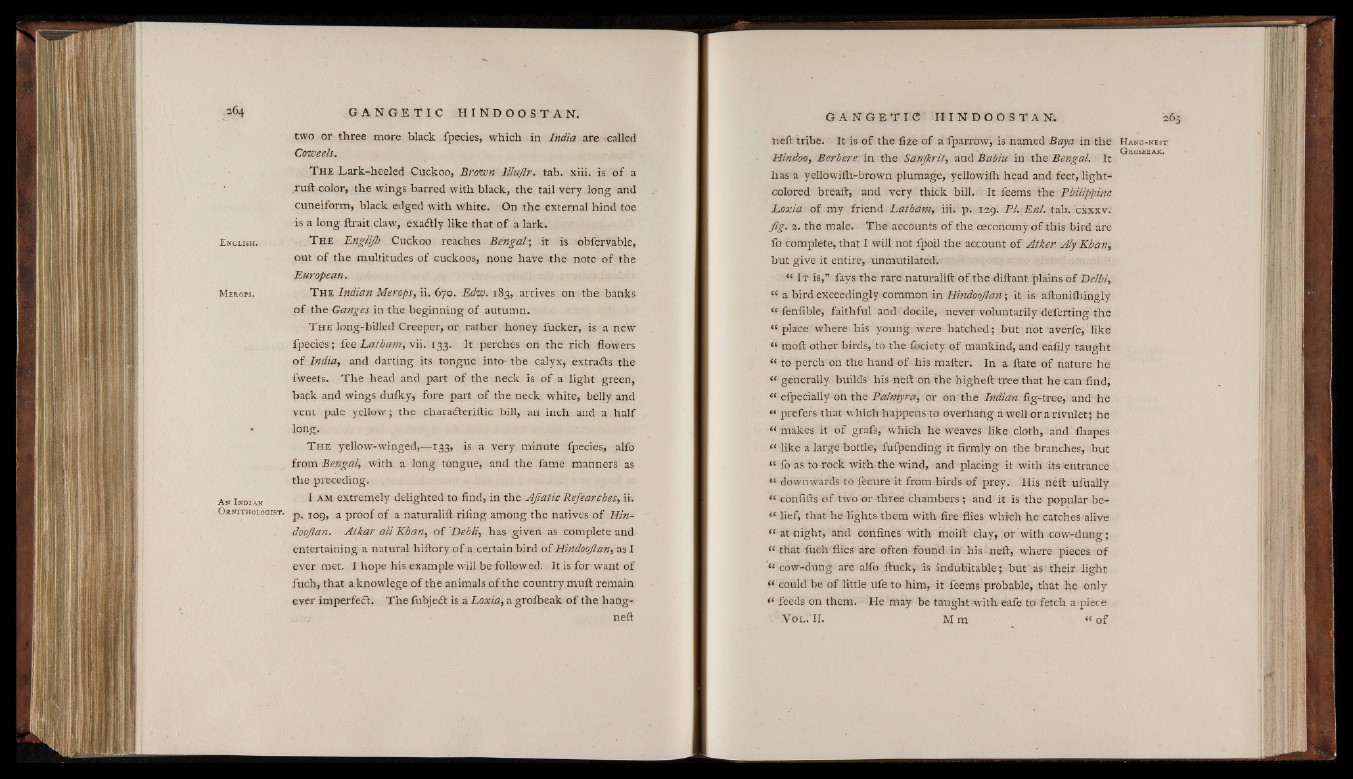
E nglish.
M erops.
A n Indian
O rnithologist.
two or three more black fpecies, which in India are called
Coweels.
T h e Lark-heeled Cuckoo, Brown lllujlr. tab. xiii. is of a
,ruft color, the wings barred with black, the tail very long and
cuneiform, black edged with white. On the external hind toe
is a long ftrait claw', exadlly like that o f a lark.
T h e Englifh Cuckoo reaches Bengal-, it is obfervable,
out of the multitudes of cuckoos, none have the note of the
European.
T h e Indian Merops, ii. 670. Edw. 183, arrives on the banks
of the Ganges in the beginning of autumn.
T h e long-billed Creeper, or rather honey fucker, is a new
fpecies; fee Latham, vii. 133. It perches on the rich flowers
o f India, and darting its tongue into- the calyx, extraits the
fweets. The head and part o f the neck is of a light green,
back and wings dulky, fore part of the neck white, belly and
vent pale yellow; the charadterillic bill, an inch and a half
long.
T h e yellow-winged,¡81-133, is a very minute fpecies, alfo
from Bengal, with a long tongue, and the fame manners as
the preceding.
I a m extremely delighted to find, in the Afiatic Refearches, ii.
p. 109, a proof of a naturalift riling among the natives of Hindoo/
tan. Atkar ali Khan, o f Dehli, has given as complete and
entertaining a natural hiftory of a certain bird of Hindoo/lan, as I
ever met. I hope his example will be followed. It is for want of
fuch, that a knowlege of the animals o f the country mull remain
ever imperfedl. The fubjeft is a Loxia, a groibeak o f the hangneft
nell tribe. It is o f the fize of a fparrow, is named Bay a in the Hanc-nest
Hindoo, Berbere in the Sanjkrit,. and Babiu in the Bengal. It &0SB~
has a yellowilh-brown plumage, yellowilh head and feet, light-
colored breall, and very thick bill. It feenis the Philippine
Loxia of my friend Latham, iii. p. 129. PI. Enl. tab. cxxxv.
fig . 2. the male. The accounts of the oeconomyof this bird are
fo complete, that I will not fpoil the account o f Atker Aly Khan,
but give it entire, un mutilated.
“ I t is ,” fa y s t h e r a r e n a t u r a l i f t o f t h e d i f t a n t p la in s o f Delhi,
“ a bird exceedingly common in Htndoojlan ; it is aftonifhingly
“ fenfible, faithful and docile, never voluntarily defefting the
“ place where his young were hatched ; but not averfe, like
*» moft other birds, to the fociety o f mankind, and eifily taught
“ to perch on the hand o f his mailer. In a ftate o f nature he
“ generally builds his nell on the higheft tree that he can find,
“ efpecially on the Palmyra, or on the Indian fig-tree, and he
“ prefers that which happens to overhang a well or a rivulet; he
“ makes it of grafs, which he weaves like cloth, and ihapes
“ like a large bottle, fufpending it firmly on the branches, but
“ fo as to rock with the wind, and placing it with its entrance
“ downwards to fecure it from birds of prey. His néft ufually
“ confifts of two or three chambers ; and it is the popular be-
“ lief, that he lights them with fire flies which he catches alive
“ at night, and confines with moift clay, or with cow-dung;
“ that fuch flies are often found in his nell, where pieces of
“ cow-dung are alfo ftuck, is indubitable; but'as their light
“ could be of little ufe to him, it feems probable, that he only
“ feeds on them. He may be taught with eafe to fetch a piece
V ol. II. Mm “ of